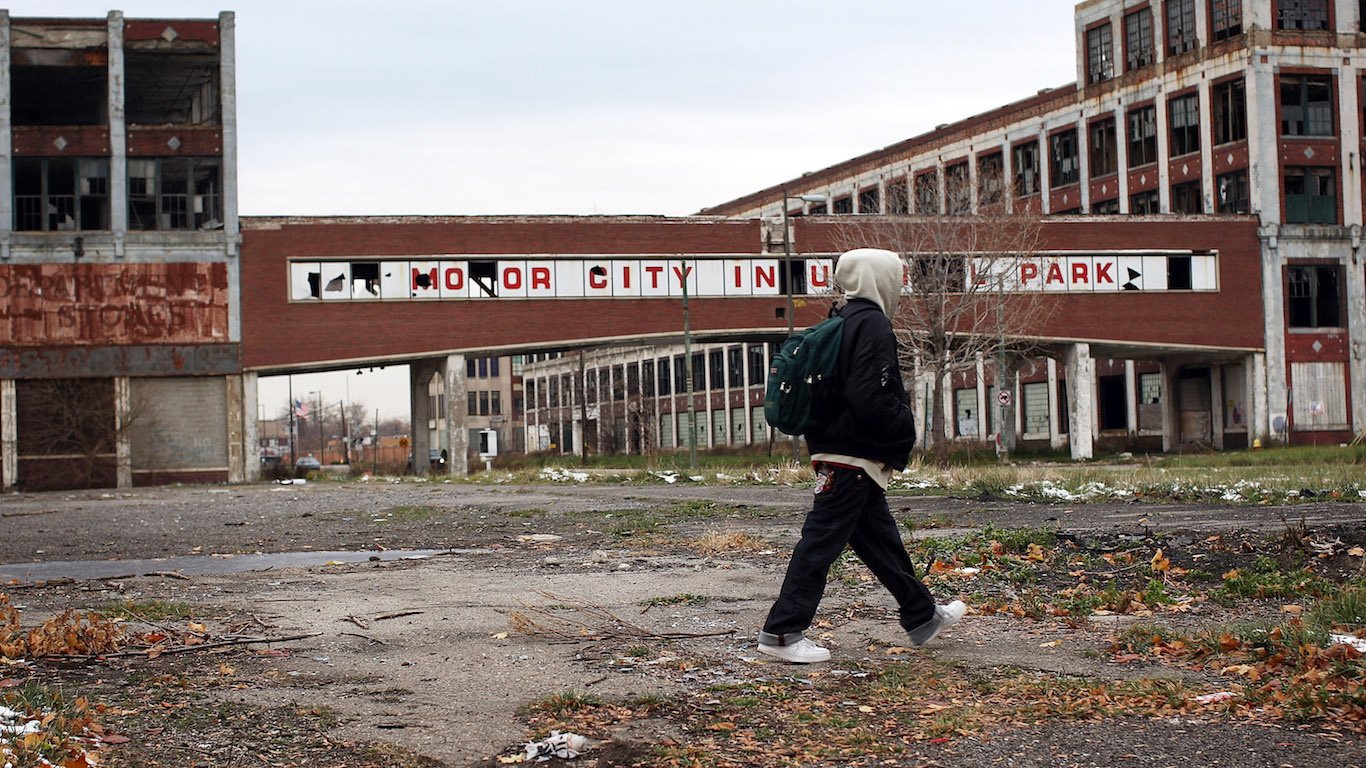

The share of children living in a single mother household has nearly doubled over the past 50 years. Single mothers in America today face unique challenges balancing the responsibilities of work and childcare and are almost four times as likely to live in poverty than the typical U.S. family.
While unmarried female householders with children are more likely to be poor, unemployed, and food insecure than married couples, some metro areas are better for single mothers than others. To determine the best (and worst) cities for single mothers, 24/7 Wall St. reviewed a range of social and economic indicators related to income, housing affordability, access to early education, and public transportation.
Click here to see the full list of the 10 worst cities for single mothers
Click here to see the 10 best cities for single mothers
Click here to read our methodology
Housing is often the biggest expense for any family and is a particularly heavy burden on single mothers. The typical unmarried female household with children in the United States earns 45.3% of the national median for all households, and there are not many options available when it comes to public programs that subsidize housing costs for single mothers. To afford an average two-bedroom apartment without spending more than 30% of her income on rent, a single mother in America would have to work anywhere from 46.0 hours a week in Midland to 181.5 hours in Santa Cruz — more hours than there are in a week.
One factor that can help reduce the burden of work and childcare for single mothers is access to high-quality preschool programs. Not only do public early education programs help set up a foundation for a child’s academic success, but they also provide families with free or subsidized childcare, often allowing single mothers the chance to pursue job or education opportunities.
Public preschool programs are often funded at the state level, and enrollment varies significantly throughout the country. In U.S. metro areas, school enrollment of 3- and 4-year-olds ranges from 24.2% in Chambersburg-Waynesboro, Pennsylvania, to 69.0% in Boulder, Colorado. Low preschool enrollment can make it more difficult to raise children for all families and not just single mothers. Here is a full list of the worst cities to raise children.
Public transportation can also help connect single mothers with job and education opportunities that they otherwise might not have access to. While nationwide 5.1% of workers commute using public transit, less than 1% of workers do in over half of all U.S. metro areas. Access to public transportation is greater in dense, urban areas, with the largest shares of commuters using public transportation in New York, San Francisco, and Washington, D.C. metro areas.
While New York City is one of the most expensive places to raise a family, it is one of the best cities for single mothers because of its universal pre-K programs and public transit infrastructure. Many other expensive cities do not have these advantages. Here is a full list of the most expensive places to raise a family.
Toughest Cities to Be a Single Mom

10. Grand Junction, CO
> Hrs./week for typical single mother to afford rent: 92.0 hours
> Market rent for two-bedroom apt.: $842
> Median income for single mother household: $16,889
> Share of 3- and 4-year-olds enrolled in school: 39.5%
In the Grand Junction metro area, just 71.2% of single mothers are in the labor force, the seventh smallest share of any metro area. The typical single mother household earns just $16,889 a year, approximately $9,300 less than the median income for single mothers nationwide and the fourth least of any U.S. metro area.
While Grand Junction is one of the less expensive real estate markets in the country, the average single mother would still need to work 92.0 hours every week to afford the average two-bedroom apartment, assuming rent amounts to no more than 30% of income, one of the longest workweeks of any city.
[in-text-ad]

9. Bakersfield, CA
> Hrs./week for typical single mother to afford rent: 84.3 hours
> Market rent for two-bedroom apt.: $926
> Median income for single mother household: $20,041
> Share of 3- and 4-year-olds enrolled in school: 34.4%
While California has the highest minimum wage in the country and is one of only a handful of states with guaranteed paid family leave, wages are low in many parts of the state and real estate unaffordable. In Bakersfield, a single mother earning the average wage would have to work 84.3 hours a week to afford the average rent for a two-bedroom apartment and still have income left over for necessities, one of the longer workweeks of any metro area.
Bakersfield also has one of the worst job markets in the country. Just 72.1% of single mothers are in the labor force, nearly the lowest participation rate of any city. Some 8.0% of the labor force is unemployed, more than double the 3.7% national unemployment rate.

8. Hanford-Corcoran, CA
> Hrs./week for typical single mother to afford rent: 87.6 hours
> Market rent for two-bedroom apt.: $987
> Median income for single mother household: $22,032
> Share of 3- and 4-year-olds enrolled in school: 32.4%
Some 8.0% of the labor force in the Hanford-Corcoran metro area is unemployed, one of the lowest unemployment rates of any metro area. Just 76.7% of single mothers are in the labor force, far less than the 82.4% national participation rate.
One factor that may contribute to low labor force participation among single mothers in Hanford is the low preschool enrollment. Access to high-quality pre-K programs can not only helps set up students for future educational success, but also can help single mothers better balance work and child care responsibilities. Just 32.4% of 3- and 4-year-olds in Hanford are enrolled in school, one of the smallest shares of any metro area nationwide.

7. Myrtle Beach-Conway-North Myrtle Beach, SC-NC
> Hrs./week for typical single mother to afford rent: 103.8 hours
> Market rent for two-bedroom apt.: $932
> Median income for single mother household: $20,086
> Share of 3- and 4-year-olds enrolled in school: 42.5%
In the Myrtle Beach metro area, it is nearly impossible for the typical single mother to afford an apartment without spending more than the recommended 30% of their income on rent. The average rent for a two-bedroom apartment in Myrtle Beach rents is $932, and the typical single mother household earns just $20,086 a year — about $6,000 less than the median for single mothers nationwide. All things being equal, a single mother in Myrtle Beach would have to work 103.8 hours a week to afford a two-bedroom apartment.
[in-text-ad-2]

6. McAllen-Edinburg-Mission, TX
> Hrs./week for typical single mother to afford rent: 81.9 hours
> Market rent for two-bedroom apt.: $757
> Median income for single mother household: $17,162
> Share of 3- and 4-year-olds enrolled in school: 37.5%
While the McAllen metro area has some of the least expensive real estate in the country, a large share of single mothers still struggle to afford housing. The typical single mother household in McAllen earns just $17,162 a year, approximately $9,000 less than the median income among all single mother households nationwide and $13,000 less than what would be needed to afford a two-bedroom apartment while not spending more than 30% of one’s income. A single mother earning the average wage in McAllen would have to work 81.9 hours a week to afford a two-bedroom apartment, one of the longer workweeks of any metro area.

5. Visalia-Porterville, CA
> Hrs./week for typical single mother to afford rent: 84.1 hours
> Market rent for two-bedroom apt.: $925
> Median income for single mother household: $20,836
> Share of 3- and 4-year-olds enrolled in school: 32.6%
The typical single mother household in the Visalia-Porterville metro area earns $20,836 a year, roughly $5,300 less than the median income for all single mothers nationwide. The low incomes are likely due in part to low labor force participation among single mothers in the city. Just 73.2% of single mothers in Visalia are in the labor force, far less than the 82.4% national figure.
One factor that may contribute to low labor force participation among single mothers in Visalia is the low preschool enrollment in the city. While preschool programs can help single mothers better balance work and childcare duties, just 32.6% of 3- and 4-year-olds in Visalia are enrolled in school — far less than the 47.5% national preschool enrollment rate.
[in-text-ad]

4. Salinas, CA
> Hrs./week for typical single mother to afford rent: 126.0 hours
> Market rent for two-bedroom apt.: $1,540
> Median income for single mother household: $27,136
> Share of 3- and 4-year-olds enrolled in school: 37.5%
Salinas is one of several metro areas in California in which it is practically impossible for the average single mother to afford an apartment without spending more than 30% of her income. The average two-bedroom apartment in Salinas rents for $1,540 a month, more than in the vast majority of U.S. metro areas. Just 74.9% of single mothers in Salinas are in the labor force, and 6.3% of the labor force is unemployed — compared to the national participation rate of 82.4% and the U.S. unemployment rate of 3.7%.
Earning the average wage, a single mother in Salinas would have to work for 126 hours to afford a two-bedroom apartment without spending at least 30% of her income on rent, nearly the longest workweek of any metro area nationwide.

3. Madera, CA
> Hrs./week for typical single mother to afford rent: 98.6 hours
> Market rent for two-bedroom apt.: $1,020
> Median income for single mother household: $18,787
> Share of 3- and 4-year-olds enrolled in school: 33.9%
The average rent for a two-bedroom apartment in Madera rents is $1,020 a month, more than in a majority of metro areas. To afford a two-bedroom without spending at least 30% of her income on rent, the average single mother in Madera would need to work 98.6 hours a week, one of the longest workweeks of any U.S. city.
Access to high-quality preschool programs can help single mothers balance work and child care responsibilities, but Madera has one of the lowest preschool enrollment rates of any metro area. Just 33.9% of 3- and 4-year-olds are enrolled in school, far less than the 47.5% national enrollment rate.

2. Jacksonville, NC
> Hrs./week for typical single mother to afford rent: 114.9 hours
> Market rent for two-bedroom apt.: $843
> Median income for single mother household: $18,041
> Share of 3- and 4-year-olds enrolled in school: 35.8%
While a resident would need to make $33,720 a year to afford the average two-bedroom apartment in Jacksonville without spending more than 30% of his or her income on rent, the typical single mother household in the metro area earns just $18,041 annually — nearly the lowest such figure nationwide. All things equal, the average single mother in Jacksonville would have to work 114.9 hours a week to adequately afford a two-bedroom apartment, the seventh most of any U.S. metro.
Access to high-quality preschool programs can not only provide children with a foundation for educational success, but also help single mothers balance child care and work. In Jacksonville, however, just 35.8% of 3- and 4-year-olds are enrolled in school, far less than the 47.5% national figure.
[in-text-ad-2]

1. Santa Cruz-Watsonville, CA
> Hrs./week for typical single mother to afford rent: 181.5 hours
> Market rent for two-bedroom apt.: $2,439
> Median income for single mother household: $31,131
> Share of 3- and 4-year-olds enrolled in school: 41.2%
The Santa Cruz-Watsonville metro area is one of several cities in California in which it is practically impossible for the average single mother to afford an apartment without spending more than 30% of her income. The average two-bedroom apartment in Santa Cruz rents for $2,439 a month, the third highest rent of any metro area nationwide.
While the typical single mother household in the metro area earns $31,131 a year — roughly $5,000 more than the U.S. median for single female householders with children — she would need to earn more than three times that to afford a two-bedroom apartment. All things being equal, the average single mother in Santa Cruz would have to hypothetically work 181.5 hours a week to afford a two-bedroom apartment, more hours than there are in a week and the most of any city.
Best Cities for Single Mothers

10. Atlanta-Sandy Springs-Roswell, GA
> Hrs./week for typical single mother to afford rent: 56.1 hours
> Market rent for two-bedroom apt.: $1,106
> Median income for single mother household: $30,827
> Share of 3- and 4-year-olds enrolled in school: 53.9%
While the average two-bedroom apartment in the Atlanta metro area rents for $1,106 a month, the high wages in the city make the Georgia capital relatively affordable for single mothers. The typical single mother household in Atlanta earns $30,827 a year, about $5,000 more than the median income for single mother households nationwide. All things being equal, a single mother in Atlanta would need to work 56.1 hours a week to afford a two-bedroom apartment without spending more than 30% of her income on rent, a shorter workweek than in most U.S. cities.
According to the National Institute for Early Education Research at Rutgers University, Georgia has one of the best state preschool programs for 4-year-olds in the country. In Atlanta, 53.9% of 3- and 4-year-olds are enrolled in school, more than the 47.5% national figure.
[in-text-ad]

9. Peoria, IL
> Hrs./week for typical single mother to afford rent: 52.1 hours
> Market rent for two-bedroom apt.: $798
> Median income for single mother household: $24,084
> Share of 3- and 4-year-olds enrolled in school: 56.7%
In Peoria, 88.0% of single mothers are in the labor force, a higher participation rate than the 82.4% national figure. The minimum wage in Illinois is $8.25 an hour, one dollar more than the federal minimum. To afford the $798-per-month average rent for a two-bedroom apartment without spending more than 30% of her income on rent, a single mother in Peoria earning the median income would need to work for 52.1 hours a week, fewer than in the vast majority of U.S. metro areas.
Affordable preschool programs can provide children with an educational foundation for the rest of their lives and help single mothers better balance work and child care responsibilities. In Peoria, 56.7% of 3- to 4-year-olds are enrolled in school, far more than the national enrollment rate of 47.5%.

8. New York-Newark-Jersey City, NY-NJ-PA
> Hrs./week for typical single mother to afford rent: 84.6 hours
> Market rent for two-bedroom apt.: $1,831
> Median income for single mother household: $30,690
> Share of 3- and 4-year-olds enrolled in school: 62.9%
High-quality, affordable preschool programs can help single mothers better balance work and child care responsibilities. New York City introduced a universal pre-K program in 2017, and in 2018, 94% of the city’s preschool programs met or exceeded the quality thresholds of the Early Childhood Environment Rating Scale, an assessment tool developed by child education experts. Currently, some 62.9% of 3- and 4-year-olds in the New York metro area are enrolled in school, the seventh highest enrollment rate of any U.S. city.
Public transit can also increase access to educational and professional opportunities for single mothers. In the New York metro area, 31.2% of workers commute using public transit, by far the largest share of any metro area in the nation. These strong factors compensate for New York’s low housing affordability.

7. La Crosse-Onalaska, WI-MN
> Hrs./week for typical single mother to afford rent: 52.2 hours
> Market rent for two-bedroom apt.: $826
> Median income for single mother household: $30,524
> Share of 3- and 4-year-olds enrolled in school: 50.6%
Low rents and high wages in the La Cross-Onalaska metro area help make the area relatively affordable for single mothers. The average two-bedroom apartment in La Cross rents for $826 a month, less than in the majority of all metro areas. The typical single mother household earns $30,524 a year, about $4,400 more than the median income for single mother households nationwide. All things being equal, the typical single mother would need to work 52.2 hours a week to afford a two-bedroom apartment in La Crosse and have income left for other necessities, a shorter workweek than in the majority of U.S. metro areas.
[in-text-ad-2]

6. Cedar Rapids, IA
> Hrs./week for typical single mother to afford rent: 48.5 hours
> Market rent for two-bedroom apt.: $812
> Median income for single mother household: $29,425
> Share of 3- and 4-year-olds enrolled in school: 51.5%
Affordable real estate and a strong job market make Cedar Rapids one of the best cities for single mothers. Some 89.2% of single mothers are in the labor force, the 13th highest participation rate of any city. And just 2.5% of the labor force is unemployed, far less than the 3.7% national figure. The typical single mother household in Cedar Rapids earns $29,425 a year, about $3,300 more than the median income among single mother households nationwide.
The average rent of a two-bedroom apartment in Cedar Rapids is $812 a month, less than in most other metro areas. While in the vast majority of U.S. cities the typical single mother earning average wages would have to work more than 50 hours a week to afford a two-bedroom apartment in accordance with recommended budget guidelines, in Cedar Rapids a single mother would have to work 48.5 hours, one of the shortest workweeks nationwide.

5. Midland, MI
> Hrs./week for typical single mother to afford rent: 46.0 hours
> Market rent for two-bedroom apt.: $821
> Median income for single mother household: $24,018
> Share of 3- and 4-year-olds enrolled in school: 55.2%
In Midland, two-bedroom apartments rent for an average of $821 a month, far less than in most U.S. metro areas. Earning the average wage for female householders with children, a single mother in Midland would have to work just 46.0 hours a week to afford a two-bedroom apartment with the rent amounting to no more than the recommended 30% of income, the shortest workweek of any U.S. metro area.
One factor bolstering incomes for single mothers in Midland is the state’s minimum wage law. The minimum wage in Michigan is currently $9.25 an hour, $2.00 more than the federal minimum.
[in-text-ad]

4. Hartford-West Hartford-East Hartford, CT
> Hrs./week for typical single mother to afford rent: 64.3 hours
> Market rent for two-bedroom apt.: $1,194
> Median income for single mother household: $32,149
> Share of 3- and 4-year-olds enrolled in school: 65.2%
While the Hartford metro area is one of the more expensive real estate markets in the country, the high minimum wage in Connecticut and high labor force participation help make the city relatively affordable. The minimum wage of $10.10 an hour in Connecticut is $2.85 more than the federal minimum. Some 86.2% of single mothers in Hartford are in the labor force, more than the 82.4% national figure.
The typical single mother household in Hartford earns $32,149 a year, approximately $6,000 more than the median income for single mothers nationwide. Earning the average wage, a single mother in Hartford would need to work 64.3 hours a week to afford a two-bedroom apartment and still have income left for other necessities, a shorter workweek than in a majority of U.S. cities.

3. Trenton, NJ
> Hrs./week for typical single mother to afford rent: 65.8 hours
> Market rent for two-bedroom apt.: $1,361
> Median income for single mother household: $34,303
> Share of 3- and 4-year-olds enrolled in school: 65.4%
High-quality, affordable preschool programs can help single mothers better balance work and childcare responsibilities. New Jersey has one of the highest-rated preschool systems in the United States and spends more per student on pre-K programs than any state. In Trenton, 65.4% of all 3- and 4-year-olds are enrolled in school, the third largest share of any metro area nationwide. New Jersey is also one of only a handful of states with required paid family leave.
Public transit can also increase access to educational and professional opportunities for single mothers. In Trenton, 7.9% of workers commute using public transit, the 11th largest share of any U.S. metro area. In addition, the required workweek to afford adequate housing within the recommended budget is about typical in Trenton compared to other metro areas.

2. Boulder, CO
> Hrs./week for typical single mother to afford rent: 61.5 hours
> Market rent for two-bedroom apt.: $1,516
> Median income for single mother household: $41,708
> Share of 3- and 4-year-olds enrolled in school: 69.0%
While nationwide single mothers earn less than half the median income of a typical household, in Boulder, the median income for single mother households is $41,708 a year — the fourth highest of any metro area and 55.1% of the median for all households in the city. The average single mother in Boulder would have to work 61.5 hours a week to afford the average rent for a two-bedroom apartment with the rent amounting to no more than the recommended 30% of income, a shorter workweek than in a majority of cities.
Affordable preschool programs can provide children with an educational foundation for the rest of their lives and help single mothers better balance work and childcare responsibilities. In Boulder, 69.0% of 3- and 4-year-olds are enrolled in school, the largest share of any metro area nationwide.
[in-text-ad-2]

1. Bridgeport-Stamford-Norwalk, CT
> Hrs./week for typical single mother to afford rent: 60.0 hours
> Market rent for two-bedroom apt.: $1,293
> Median income for single mother household: $33,641
> Share of 3- and 4-year-olds enrolled in school: 68.5%
While the Bridgeport metro area is one of the more expensive real estate markets nationwide, a single mother earning the average wage in the city would need to work 60.0 hours a week to afford a two-bedroom apartment and still have enough income for other necessities, a shorter workweek than in a majority of U.S. metro areas.
Government-subsidized services like public preschool and public transportation can improve the quality of life of single mothers. In Bridgeport, 68.5% of 3- and 4-year-olds are enrolled in school, the second largest share of any city. Some 10.4% of workers commute using public transit, the sixth largest share.
Methodology
To determine the best and worst cities for single mothers, 24/7 Wall St. compiled an index of six measures for each U.S. metro area:
1) the median income for a single mother household with children under 18 years old
2) the share of single mother households in poverty
3) the average income deficit for single mother households below the poverty line
4) the share of three- and four-year olds enrolled in school
5) the share of workers over 16 years old using public transportation to commute
6) the number of hours a week a single mother earning the median income would need to work to afford a two-bedroom apartment at fair market rent (FMR) in the 2019 fiscal year.
FMR is the 40th percentile of gross rents for typical, non-substandard rental units in a given metropolitan statistical area (MSA) and is determined by the U.S. Department of Housing and Urban Development. The number of hours a week a typical single mother would need to work to afford a two-bedroom apartment at fair market rent is based on methodology developed by the National Low Income Housing Coalition using weekly wage estimates for 2018 from the Bureau of Labor Statistics. To be considered affordable, rent has to be no more than 30% of income.
The measures were normalized and organized in four categories — income, early education, public transportation, and housing affordability. The number of hours a week a typical single mother would need to work to afford a two-bedroom apartment at FMR was given double weight, public transit use was given quarter weight, and income, poverty, and average income deficit were averaged and treated as one standard measure.
MSAs for which the margin of error on single mother households at 90% confidence was 10% or greater than the point estimate were excluded. All data, other than the FMR, came from the U.S. Census Bureau’s American Community Survey and are five-year estimates for 2013 to 2017.
Essential Tips for Investing: Sponsored
A financial advisor can help you understand the advantages and disadvantages of investment properties. Finding a qualified financial advisor doesn’t have to be hard. SmartAsset’s free tool matches you with up to three financial advisors who serve your area, and you can interview your advisor matches at no cost to decide which one is right for you. If you’re ready to find an advisor who can help you achieve your financial goals, get started now.
Investing in real estate can diversify your portfolio. But expanding your horizons may add additional costs. If you’re an investor looking to minimize expenses, consider checking out online brokerages. They often offer low investment fees, helping you maximize your profit.
Thank you for reading! Have some feedback for us?
Contact the 24/7 Wall St. editorial team.
 24/7 Wall St.
24/7 Wall St. 24/7 Wall St.
24/7 Wall St. 24/7 Wall St.
24/7 Wall St. 24/7 Wall St.
24/7 Wall St.


